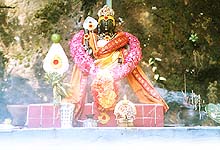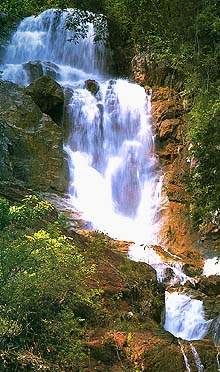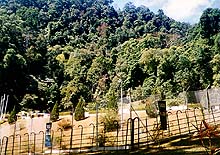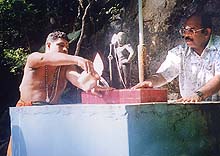|
I then watched the worshippers perform a beautiful ritual of gently washing the idol and dressing the deity in ceremonial saffron robes. The drums and trumpets reverberated amid low unceasing vibrations of cicadas and birds.
The heavy growth of fronds and thick boughs and the hanging wild vines appeared to welcome the annual guests in this spiritually charged natural setting.
The image of Muruga lies next to a big iron Vel, the god's symbol, that is embedded in a concrete slab. The Vel is believed to have been placed there during the 1780s by Indian labourers used by the British to transport water from the waterfall to George Town.
Apparently, the bottom section of the Vel was broken after some years. The Vel, however, has been kept at its place, but covered with concrete with only the top part showing.
It is said that a Hindu monk was taken by the waterfall's setting and inspired the building of the shrine, when the Indian workers were transporting water towards George Town on bullock carts.
The monk was not alone in being affected by the site. British Captain James Low wrote a lengthy article about the place in the 1830s.
Charles Dyce also wrote: "The waterfall amply repays one for the scramble and loss of wind necessary to reach a convenient spot: once seated on some rocky ledge one feels disinclined to descend again and encounter the burning sun."
According to an official notice near the base of the waterfall, early paintings and photographs showed an Indian shrine at the foot of the falls. Records also indicate an old Muslim grave of 'Chenana' on the hill above the waterfall, bearing his name.
It is interesting to note that the waterfall has been one of the historical sources of water for George Town and ships that called at Penang. In fact, in 1805, an aquaduct was built from the waterfall via Pulau Tikus to a reservoir near Leith Street Ghaut and Hutton Lane respectively.
For me, the experience of the morning was uplifting and singular.
Trekking up the hill, witnessing the prayers and breathing the sprightly air of nature. I felt the site to be a consummation of deep spirituality, history and nature. An ancient religious monument, virgin greenery and the great waterfall nestled amid craggy vertical columns of sheer hillside.
I could think of few places on Earth fit for the Lord Muruga, prince of righteousness and protector of the innocent, to perch with his solid omniscient smile, as he calmly regarded the world before him.
|








No comments:
Post a Comment